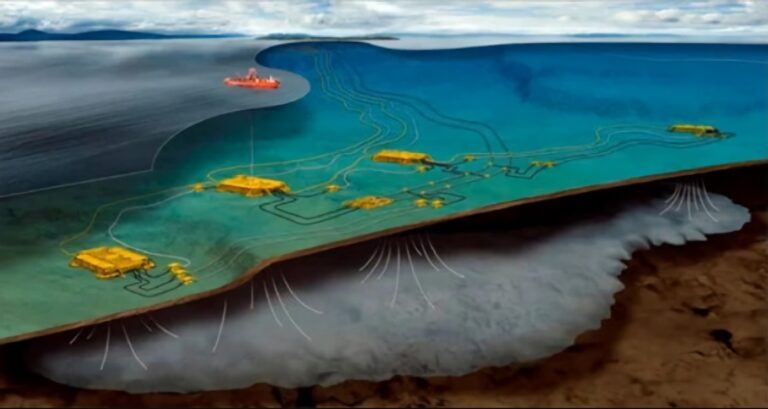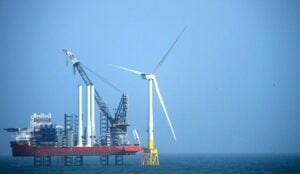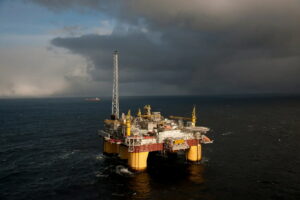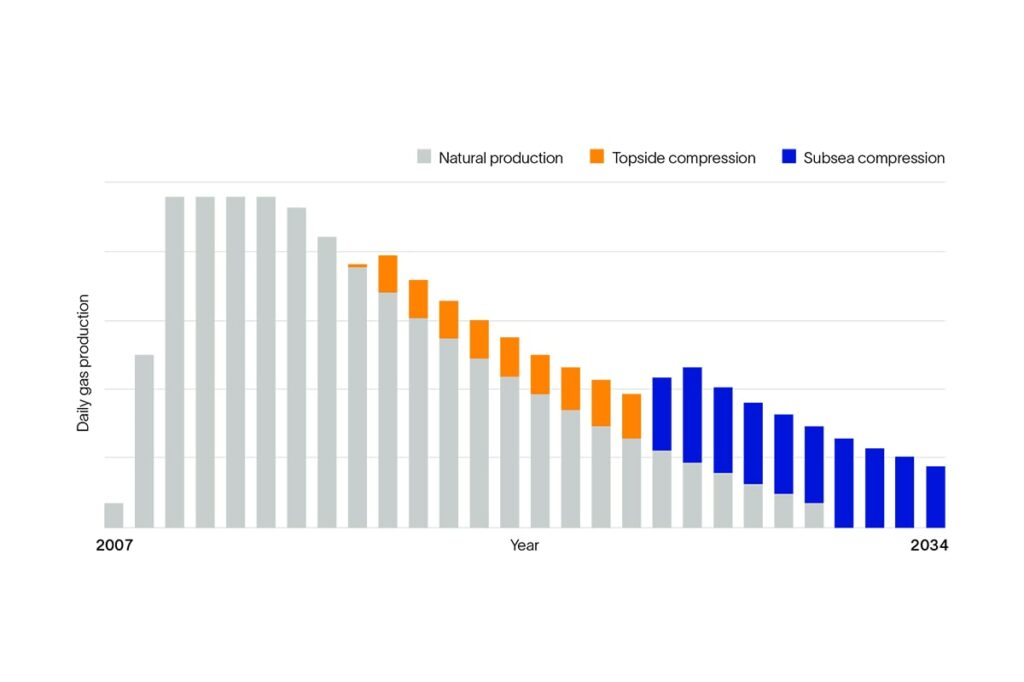Home Fossil Energy Electrification: Key to unlocking untapped oil & gas reserves and augmenting production
The oil and gas industry is always on the lookout for ways to boost production levels at offshore fields and gain access to stranded and untapped reserves that are not easy to bring online. Electrification of subsea production systems (SPS) offers the solution to these long-standing issues and constraints while also enabling decarbonization and lowering expansion costs, according to OneSubsea, a joint venture between Subsea7, SLB, and Aker Solutions.
 Ormen Lange development; Source: Shell
Ormen Lange development; Source: Shell
Bearing in mind the benefits not just on production but also on curbing greenhouse gas (GHG) emissions footprint, producers are increasingly turning to offshore platform electrification to optimize their oil and gas assets with renewable energy, such as offshore wind, subsea cables for power transmission, combined cycle power production, and energy storage systems. This is quickly replacing diesel generators while opening doors to remote monitoring and management of these offshore assets. The electrification trend offers a ray of hope amid growing concerns over energy security and climate woes.
A Global Market Insights report, published earlier this year, indicated that the offshore platform electrification market size was valued at $1.6 billion in 2022. However, it is well positioned to grow at 19.7% CAGR from 2023 to 2032, thanks to two main growth drivers, which encompass stringent regulatory norms toward emissions and favorable policies for renewable energy – both of which have been identified as the main objectives of the global energy industry during COP28.

video
Posted: 16 days ago
The offshore platform electrification market value in 2032 is expected to be $6.8 billion, as the global energy industry landscape becomes increasingly energized with renewable energy technologies, covering offshore wind turbines, floating solar arrays, and efficient power storage systems in combination with feasible and economically viable offshore platform electrification constellation.
In line with this, the increasing push towards energy transition to cleaner sources of supply is expected to continue bolstering the offshore oil and gas producers’ efforts to decarbonize their operations with electrification as one of the most sought-after means of accomplishing this feat. The subsea power transmission solutions are expected to play a crucial role in transmitting electricity from offshore wind farms or other renewable energy sources to the platforms situated offshore, based on the report’s findings.
As a result, the demand for HVDC cables and more efficient transfer of electricity over longer distances is expected to usher in a further surge in demand for the electrification of offshore platforms. Global Market Insights believes that Europe’s offshore platform electrification market will amass $6 billion in 2032, thanks to the development of new and expansion of existing offshore wind farms as the investments in offshore platform electrification ramp up the deployment of renewable energy technologies.
In addition, the advancements in subsea power transmission technologies such as innovative cable designs are expected to further strengthen the electrification business outlook. When compared to other regions around the world, Europe will reap the benefits from certain policies that offer support for further offshore platform electrification projects such as the European Green Deal and the high renewable energy targets the European Union has set to reach its net zero goals.
The report outlines several major players in the offshore platform electrification market, including ADNOC, BP, Prysmian, Aker Solutions, Siemens Energy, Equinor, Nexans, SLB, NKT, etc. Many companies and governments are also looking into the potential of converting the existing fossil fuels infrastructure for use in the offshore wind industry, giving a new lease of life to oil and gas platforms while slashing offshore installation costs for renewable energy operators. However, electrification is currently the dominant trend in the offshore oil and gas industry.

long read
Posted: 7 months ago
OneSubsea is convinced that electrification opens up new opportunities for the future of the subsea market, “as all-electric systems can pave the way for longer subsea tie-back systems, helping to unlock distant stranded reserves, at a lower environmental footprint.” These all-electric systems serve as a way to overcome some of the inherent technical limits faced by electrohydraulic ones. While SLB has a 70% equity stake in OneSubsea, Aker Solutions and Subsea7 hold 20% and 10% interest, respectively.
The joint venture elaborates that subsea boosting and compression systems offer a helping hand in unlocking a field’s full potential by increasing drawdown beyond what is possible with the reservoir’s natural drive for long distances. These long subsea tie-backs to existing infrastructure minimize capex and project lead times while simultaneously enabling production from otherwise non-viable fields. Two case studies provided by OneSubsea serve to illustrate the benefits of subsea compressions.
Åsgard: Compression lends a hand to tackle subsea challenges
OneSubsea claims that “the world’s first subsea gas compression system” came online at Equinor’s Åsgard field in September 2015 to improve recovery while slashing energy consumption and CO2 emissions across the life of the field. The joint venture explains that moving gas compression from the platform to the wellhead can boost recovery rates up to 90%, enabling the extraction of an extra 306 million boe of gas.
The company continues to work with Equinor to prepare for extended operations at the field, find solutions to enhance production, and extend the field’s lifetime as the pressure in the reservoir naturally declines. To this end, 2015 witnessed the installation of a compression system at Åsgard on the seabed to improve recovery rates and reduce capital and operating costs. The system included modules for two identical sets of compressors, pumps, scrubbers, and coolers, fitted together in a 1,800-metric ton steel frame.
When 2021 rolled in, module 4 was delivered in the Åsgard subsea compression project, a dual-function module with pilot-testing capabilities in addition to having all the required actions for continuous subsea operation. The engineering is based on the phase one design with necessary modifications to incorporate an additional overhung compressor and liquid injection in the revamped HP compressor. The joint venture player elaborates that the key engineering challenge covered the incorporation of more equipment and larger pipe sizes while maintaining total weight and structure dimensions.
Furthermore, Åsgard subsea compression project phase II was completed by May 2022. OneSubsea deems this achievement to be “a critical milestone” in enabling production extension and setting the field up for constructing and delivering module 5 by the end of June 2025. The Åsgard project’s subsea gas compression system has run with an uptime of close to 100%, with a 5 billion NOK ($492.55 million) additional revenue generated by the licensees in the first year of subsea compression technology use.

Posted: 5 months ago
By using subsea multiphase compression, the joint venture points out that Åsgard should see recovery boosted by approximately 306 million barrels across its life, which translates to a recovery rate of 90%, up from less than 60% pre-subsea compression.
“This subsea technology yields a significant reduction in energy consumption and CO2 emissions in a life-cycle account for Åsgard. Through further optimization, the technology also represents a potential for additional CO2 reductions in future subsea solutions,” added OneSubsea.
Located at Haltenbanken in the Norwegian Sea, about 200 kilometers from the Trøndelag coast and 50 kilometers south of the Heidrun field, the Åsgard field development concept includes the Åsgard A production vessel, the Åsgard B semi-submersible platform, and the Åsgard C storage vessel. The field has been producing oil since May 1999 and gas since October 2000.
The Åsgard facilities currently receive oil and gas from seven different fields: Midgard, Smørbukk, Smørbukk South, Mikkel, Morvin, Smørbukk Northeast and Trestakk. Morvin – four wells and two subsea templates – and Mikkel – three wells and two subsea templates – are also tied into the infrastructure at Åsgard B.
The gas from the Åsgard field is routed by pipeline to Kårstø in Northern Rogaland County, where heavier components such as ethane, propane, butane, and naphtha are separated. From there, the dry gas is transported onward via the Europipe II pipeline to customers on the continent.
Ormen Lange: subsea compression powered by low-carbon electricity
Back in September 2021, Shell submitted its plan for development and operation (PDO) of the Ormen Lange wet gas subsea compression project to the Norwegian Ministry of Petroleum and Energy. This was approved in July 2022 and is expected to unlock an additional 30-50 billion cubic meters of natural gas, leading to an increase in Ormen Lange’s overall gas recovery rate. OneSubsea outlined that it was building “the world’s deepest subsea compression facility” at the field, representing one of Norway’s most complex and technically challenging locations.
Discovered in 1997 and producing since 2007, the field has now produced about 55% of its gas reserves and there is a need to extend its lifetime and maximize recovery. This is said to be one of the lowest carbon footprint developments globally, with green hydroelectric energy powering the subsea compressors. OneSubsea is in charge of the manufacture and installation of the subsea systems under a contract won back in 2019.
“No other Norwegian field produces from such deep water, under such harsh conditions and with such advanced equipment as the Ormen Lange field. To extend its lifetime and maximize recovery, we co-designed with our customer a subsea compression system powered by low-carbon electricity and operating at a water depth of 900 m,” highlighted the joint venture company.

Posted: about 1 year ago
As the Orman Lange project comes with a subsea compressor installed 120 km from the onshore facility, OneSubsea underlines that this has never been done before and is “a genuine step-change” for the wider industry. The system’s two compression stations contain two compression modules – each compressor being able to provide up to 50-bar differential pressure (DP), configured in parallel for a large volumetric flow capacity.
Moreover, the joint venture underscores that the 32-MW subsea multiphase compression system will use onshore VDSs located 120 km away, eliminating subsea VSDs or topside alternatives to improve project economics. Following commissioning, the subsea live data-driven performance service will use remote monitoring and data analysis to optimize performance.
“Our award-winning subsea multiphase compressor is the world’s first and only true subsea wet gas compressor. Conventional compressors require perfectly dry gas to operate safely and efficiently, whereas our subsea compression system can operate with the unprocessed multiphase well stream,” added OneSubsea.
The company is adamant that the Ormen Lange will unlock a further 30-50 billion cubic meters of natural gas from the field by using subsea multiphase compression. This will augment the recovery rate from 75% to 85% while halving the field’s energy consumption by 50% per unit volume of gas produced, compared with a conventional topside solution.
 Ormen Lange gas production; Source: OneSubsea
Ormen Lange gas production; Source: OneSubsea
Located 120 kilometers (75 miles) off the coast of Norway, the deepwater Ormen Lange field produces gas, which meets around 20% of the UK’s gas needs. After being discovered in 1997 while the original plan for development and operation was approved in 2004, the field was put into production in 2007.
The Ormen Lange field operates without a platform and includes 19 wells divided between four templates on the seafloor while two 30-inch pipelines transport the gas to the Nyhamna terminal for processing, where it is separated into natural gas and condensate for export before being exported via Sleipner to Easington.
Shell is the operator of the project with 17.81% interest while its partners are Petoro (36.48%), Equinor (25.34%), PGNiG Upstream Norway (14.02%), and Vår Energi (6.33%).
>>> Read full article>>>
Copyright for syndicated content belongs to the linked Source : OffshoreEnergy – https://www.offshore-energy.biz/electrification-key-to-unlocking-untapped-oil-gas-reserves-and-augmenting-production/































